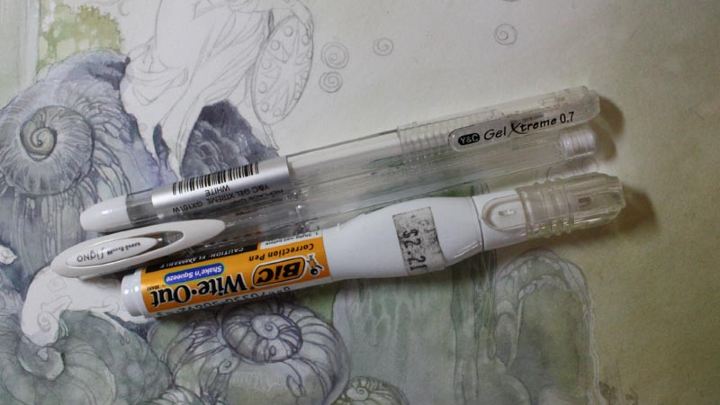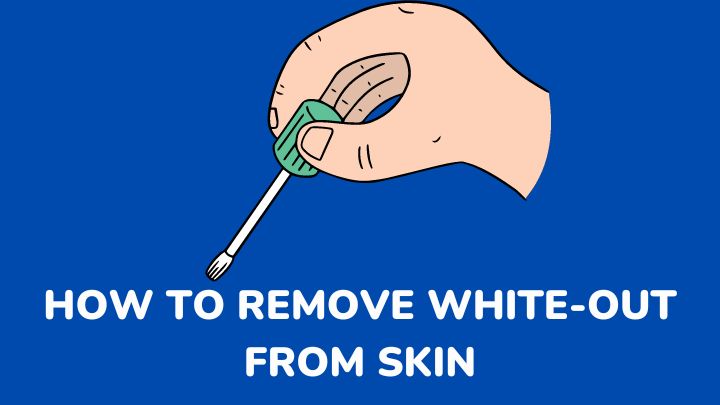White-out or correction fluid is an essential stationary tool for those who write, edit, and correct on paper a lot, including children! So you would often find mishaps of it spilling on your skin. When you want to remove white-out from the skin, you need to handle the situation with care.
That’s because the fluid is a plaster that sticks when dried, which makes it difficult to remove with just water. While white-out is a liquid paper that is permanent on paper, it doesn’t mean there are no solutions to removing it from the skin.
If you find yourself in a bind with white-out dried on your skin, here are ways to remove the fluid.
How to remove white-out from skin
1. Soap and water solution
This is actually the first thing you should try, especially when the fluid is still drying. The soap and water mix contains molecules that can break down particles and oil.
Use mild soap and water to wash your skin. The gentle soap will not react on your skin or leave it dry. You can use your hands or washcloth to rub the stain off the affected area.
2. Apply rubbing alcohol
Rubbing alcohol can also remove tough stains and neutralize particles. Simply dab a cotton ball or pad with rubbing alcohol and gently rub it onto the affected area. It will dissolve the dried liquid paper on your skin in no time.
3. Use nail polish remover
Nail polish remover works just like rubbing alcohol. Nail polish removers have a good amount of acetone that neutralizes chemicals and particles. If rubbing alcohol does not work, you can try using a nail polish remover.
Just apply it to the skin using a cotton ball or pad and gently rub it onto the affected area. Be careful not to use too much or leave it on too long, as acetone can dry up and leave behind residues.
After removing the polish remover, moisturize your skin to prevent drying out that area.
4. Baby oil
Baby oil can also remove white-out from the skin. All you need to do is rub the oil on the affected area, leave it to liquefy the dried fluid, then use an old toothbrush or loofah to scrub off white-out on your skin and rinse with water.
Contact with a loofah or toothbrush can be abrasive, so gently scrub off the white-out.
5. Olive oil
Olive oil works in two ways- it removes the stain and moisturizes the skin. You simply apply the oil to the affected area, leave it for a few minutes, then use a cotton ball to rub off the oil along with the white-out stain.
How to remove white-out from clothes
The skin is not the only thing that can get white-out stuck on it; clothes can too. Removing white-out or correction fluid from clothes can be tricky based on the fabric (especially cotton), but here are some methods that will help.
Try scrapping off the fluid: Use a spoon or dull knife to gently scrape excess or dried white-out fluid from the fabric. Be careful not to spread the stain further.
Apply rubbing alcohol: With a rubbing alcohol-soaked cotton ball or pad, gently blot out the stain. This will help to dissolve and remove the white-out.
Use a stain remover: You can also apply a stain remover or pre-treatment product directly onto the stain and let it sit for a few minutes, then wash it off. Be sure to follow the instructions on the product before using the treatment.
Use hydrogen peroxide: Another way is to use hydrogen peroxide. Mix a solution of one part hydrogen peroxide and one part water, then apply it directly to the stain. Let it sit for a few minutes, then rinse with water and wash the clothing as usual.
Try baking soda and vinegar: A baking soda paste contains molecules that can neutralize correction fluid. Make a paste of baking soda and vinegar and apply it to the stain. Let it sit for a few minutes, then rinse with water and wash the clothing as usual.
How to prevent white-out from spilling

- Keep the cap on tight: Make sure the cap of the white-out is securely fastened when not in use. This will prevent the product from drying out and spilling when opened suddenly.
- Store the product safely: Store the correction fluid upright in a cool, dry place. This will prevent it from leaking or spilling due to changes in temperature or humidity.
- Use a steady hand: When using the fluid, hold it steady and use a light touch. Steady hands will help apply the correct amount of product without spilling it.
- Work in a well-lit area: Work in a place with enough lighting where you can clearly see what you’re doing. This will prevent mishaps on your skin or clothes.
- Keep it out of reach of children and pets: White-out and other correction fluids should be kept out of reach of children and pets. They can be toxic if ingested or inhaled.
FAQs
Is white-out stain permanent?
No, it is not. Even if you do leave out white-out on your skin, it would come off eventually. The same cannot be said for clothes. However, with enough wash, the stain will gradually fade away.
Is white-out stain dangerous?
No, it is not. As long as white-out is not ingested, it does not pose a threat to your skin other than the discomfort you feel looking at the stain.
Can you use coconut oil to remove white-out stains?
Yes, you can. Coconut oil, like olive oil, can remove white-out stains. So if you have the oil available instead of olive oil, you can use it.
Conclusion
White-out is not dangerous to the skin, but it can get tricky to remove when dried. If you want to effectively get the stain off your skin, try rubbing alcohol, baby oil, nail polish remover, or the classic soap and water solution.
Nevertheless, preventing the fluid from spilling is still the best form of care. Therefore, do not shake it too hard, use it in a well-lit area, and keep it out of reach of children and pets. Things get messy when that happens. With these tips, you can prevent another household mishap.
Thanks for reading.
Get more skincare hacks here on MBGON.
